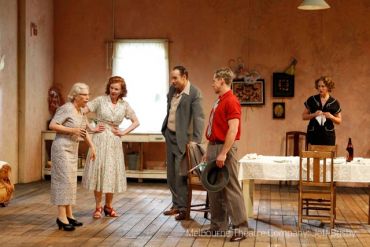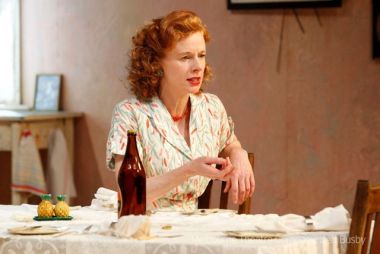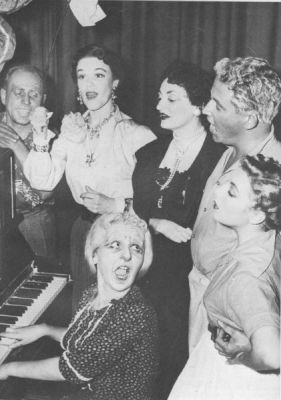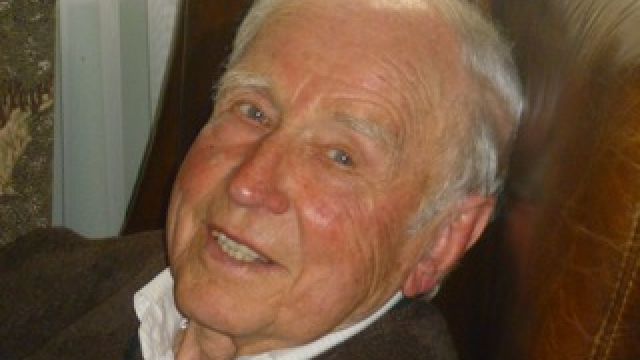Summer of the 90th Year for our ‘Doll’ Playwright.
56 years after its premiere in Melbourne, The Summer of the Seventeenth Doll by Ray Lawler is a hit all over again under the direction of Neil Armfield, selling out last year in Sydney at Belvoir and now opening in Melbourne, Wollongong and Brisbane. ‘The Doll’ is lauded as a game changer for Australian theatre, not only because it portrayed Australian life, but because it was the first Australian play to tour internationally. Lucy Graham caught up with the ninety-year-old playwright Ray Lawler at his bayside home in Melbourne.
Ray Lawler doesn’t know what inspired Summer of the Seventeenth Doll. Nor can he adequately explain how a boy with a crippled hand and foot, whose family had no interest in theatre and who left school at 13, became a celebrated playwright.
For 11 years after leaving Footscray state school, Lawler worked in an agricultural implements factory, to the backdrop of blacksmiths, presses, furnaces and rough language.
‘There was lots of noise, lots of dirt, and lots of heat. And there was lots of day-dreaming because it was so mechanical it left your mind free. God knows how I got interested in theatre, because I was one of eight kids and we had no theatre in the family. I started to go on my own to see plays, whatever it was that Williamsons were putting on.’
Hearing Lawler’s lyrical voice now it’s hard to imagine he once had ‘the broadest of Australian accents,’ a severe theatrical impediment for Australian actors in the 1940s.
 ‘People don’t realise that before theatre was funded it depended entirely on bums-on-seats. Williamsons ran professional theatre in Australia and New Zealand. Nobody did Australian plays. They would get the Australian rights for the hit play in London or New York, and bring out a couple of stars. Small parts would be played by Australians who would drop their Australian accents. That was the first thing you had to do if you wanted to be an actor.’
‘People don’t realise that before theatre was funded it depended entirely on bums-on-seats. Williamsons ran professional theatre in Australia and New Zealand. Nobody did Australian plays. They would get the Australian rights for the hit play in London or New York, and bring out a couple of stars. Small parts would be played by Australians who would drop their Australian accents. That was the first thing you had to do if you wanted to be an actor.’
Lawler persuaded a third-generation actor, Lorna Forbes, ‘a dear majestic woman, and a very good teacher,’ to teach him, paying her out of his meagre wage.
“She looked at me and said, ‘Well I don’t know, you’re very short, but if you want to try, alright,’ and she took me to bits immediately. One of the very first things was she got me to read, and the word ‘just’ I‘d been pronouncing as ‘jest’. She said ‘Jest is something a jester makes.’And she started to clean up my act a little.”
During World War II, the factory switched to war production, often requiring Lawler to work the night shift, and slowing his acting aspirations.
“That drove me to writing more than acting. That’s how it went on until the war finished. I was 24 and I thought, ‘Well now I’ve got to try and support myself and try and do something.’ I wrote radio scripts, but my love was theatre.”
Life was very rough at times but an opportunity to assist American variety comedian Will Mahoney, married to Evie Hayes, with his memoirs, led to an opportunity to travel to Brisbane and play alongside Mahoney as the straight man.
“That was my first professional job in theatre. I was there for a year doing fortnightly change variety, vaudeville, and I enjoyed it tremendously.”
Next Lawler was offered a salaried job with the National Theatre back in Melbourne which included office work, a position he led for a couple of years, until John Sumner arrived and opened the Union Theatre Repertory (now the MTC) at the University of Melbourne.
“I was writing the first version of The Doll and I wanted to finish the play first, but I joined them for the 2nd year of the company. John Sumner asked if I would direct. I wanted to act but there weren’t often parts suitable for me.”
In 1955, when ‘The Doll’ opened, it was a ‘wild success,’ with Lawler directing and playing Barney.
 “I always used to write a part for myself because I was very short and I knew there wouldn’t be anyone else. So while I never wrote a leading role for myself, it was always something decent.”
“I always used to write a part for myself because I was very short and I knew there wouldn’t be anyone else. So while I never wrote a leading role for myself, it was always something decent.”
A two-week Melbourne season grew to three, followed by four weeks in Sydney, and an Australian tour in 1956. Lawrence Olivier heard about the play, and decided to present it in England, and so in 1957, for the first time, a quintessentially Australian play with an entirely Australian cast went overseas. It won ‘play of the year’ in the West End but flopped on Broadway because the audience could not understand the accent.
It’s no surprise that Lawler still knows the script backwards. He was in the audience for the most recent production of ‘The Doll’ at Belvoir Theatre in Sydney. He was even seen mouthing the words.
‘Well I certainly wasn’t mouthing them so anyone could hear them,’ he said with a blush.
But it shows he still knows all the lines.
‘Having been in it from ‘55 – ’58 we knew it backwards and I’ve seen it quite a bit since. ’
The most recent Sydney production received excellent reviews. Unique touches included having the window of the theatre become the window of the set so you could hear the outside traffic of Belvoir Street inside the venue. They also cooked real bacon off stage, sending the smell across the audience.
 Did Ray Lawler like it?
Did Ray Lawler like it?
“In every production there are gains and losses and some things I thought ‘well that comes off very well and is a plus’ and some things not.
“Their whole style is about cutting everything back to essentials – decoration, they’re not interested in that. So the set was not at all what it was described as in the play.
“They had lots more movement, much more than I’ve seen before. What it did was make all the characters seem much younger, which was very interesting because it gave a lot of vigour and vitality to it.”
One of the delights in the play is hearing the wonderful expressions used in 1950’s. Mad as a cut snake is one that comes to mind.
‘We talk about the ’guys’ now. In our day we were called blokes or jokers – we had about five or six names for them and you knew by the one they used what sort of person they were.’
But despite the play being very much about sex and violence, there is no swearing. It’s something that Ray Lawler has little time for.
“I think if you use that sort of language quite a lot in a play the audience think ‘oh yes, yes, fine,’ and it goes on and on and their ear just tunes in and it means nothing after a time. Whereas if you use it sparingly and when it’s needed it had much greater effect and can get a laugh. In my day certainly there were certain words that were not only not used in theatre but they wouldn’t be used in normal conversation. I mean some of the four-letter words, you’d have to be very very careful.”
When he wrote the play he was a 30 year-old writer. It is perhaps unusual for someone of that vintage to explore the themes of ageing and mortality, but Lawler considers the Great Depression and World War II made for different times.
‘We were much older in feeling than people of that age are nowadays. They were much tougher times. So I didn’t feel very young I must say, not at all. It’s the loss [for the characters] of course, the loss of youth. They had this time in which they’d built it all up and it’s all in their mind really and they’re thinking that it’s going on forever. It’s all eventually going to fall about their ears.”
These days this gracious gentleman, to whom Australian theatre owes much, is putting his plays into a definitive form before he ‘pushes off’.
“I’ve got quite a lot of plays that I was never very happy with, and I’m putting them into a final form. I’m spending a lot of time doing that and it keeps me happy without meaning very much I think.”
From this writer’s perspective, ‘The Doll’ still means a great deal in theatre circles, and has made an indelible impression. There is no reason to suppose it will be any different for future generations.
Summer of the 17th Doll plays at the Arts Centre, Playhouse (Jan 12 – Feb 18), at The Playhouse, QPAC (Feb 22 – Mar 11) and IPAC, Wollongong (Mar 21 - 24).
Images. (Top) Ray Lawler. Middle two images from the 2012 Melbourne season - (L to R) Robyn Nevin, Alison Whyte, Steve Le Marquand, Travis McMahon and Helen Thomson, & Alison Whyte. Photographer: Jeff Busby. Lower: Original Australian Cast.
Originally published in the January / February print edition of Stage Whispers.
Subscribe to our E-Newsletter, buy our latest print edition or find a Performing Arts book at Book Nook.

